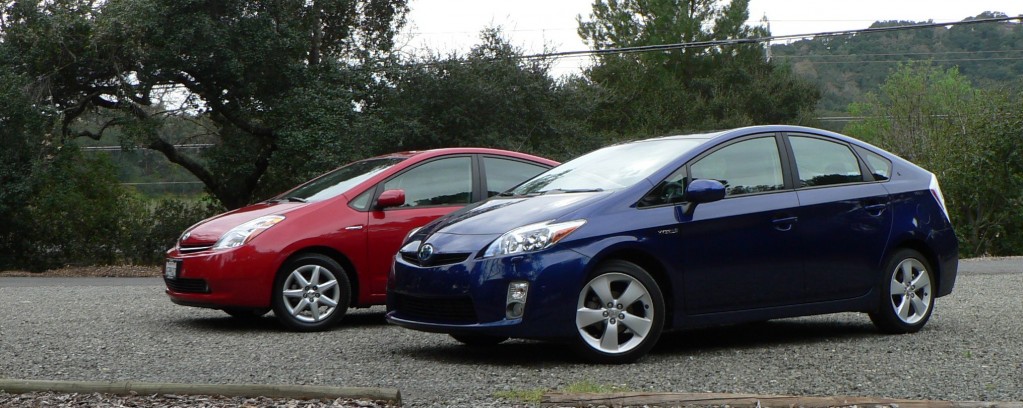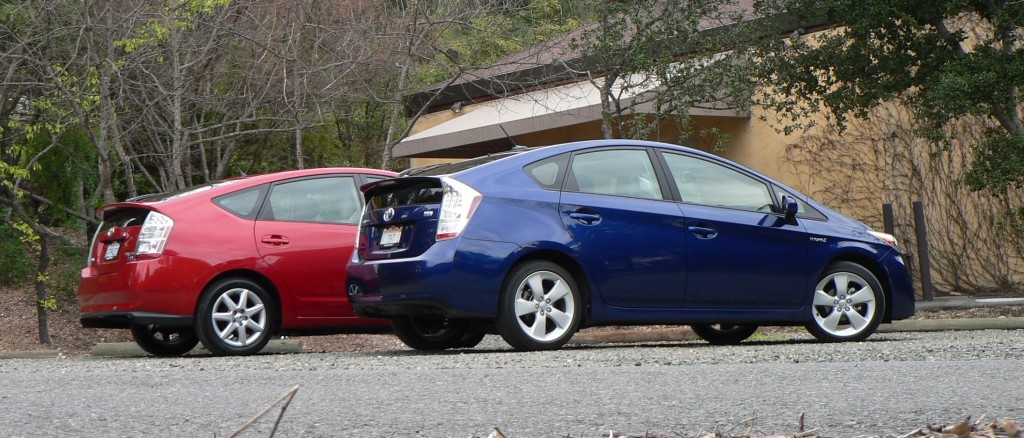Feature: Prius grows up
Story and photos by John LeBlanc
While taking some photographs of the latest version of the Toyota Prius in a parking lot at one of the many wineries lining the hills in the Napa Valley, a well-kept baby boomer approached me cautiously.
“Is that the new Prius?” she asked, looking for all the world like a red-headed Meryl Streep.
Upon hearing that it was, her apprehension melted away. She quickly started gushing that both her and her husband, who live in the tony town of Mountain Valley just north of San Francisco, each own a previous-generation Prius.
And despite making a point that they could afford to spend more – much more – for their cars, she enthused how they “just loved” their pair of Toyota hybrids.
“Oooo,” she cooed as she stalked the latest model. “This new one’s much prettier. But does it get better gas mileage?”
Yes, Virginia (or Meryl, or whatever your name was), in developing its third-generation Prius, Toyota didn’t mess with its super fuel-efficient low-emission crown jewel.
The Japanese automaker estimates that the 2010 Prius will only consume 3.8 L/100 km (74 m.p.g.), combined city and highway driving. That’s better than the 4.1 L (69 m.p.g.) for the previous generation (introduced in 2004) and the 4.6 L (61 m.p.g.) for its predecessor – the first Prius that went on sale in Canada in 2000.
It’s also better than its two direct competitors: the $25,775 Volkswagen Jetta Wagon TDI diesel (6.8 L/4.8 L, or 41/59 m.p.g.) or the new Honda Insight hybrid (4.8 L/4.5 L, or 58/63 m.p.g.), which may be priced at around $23,000.
As my parking lot stalker showed, there’s been a palpable sense of anticipation among the Prius nation for this version of the iconic hybrid.
The first-generation Prius, which entered its Japanese home market in 1997, was the world’s first mass-produced hybrid. A small, awkward-driving (and looking) compact sedan created to showcase Toyota’s engineering prowess, it was more of a niche product.
The real product and sales breakthrough came with the second-generation Prius in 2004. Completely redesigned into a larger hatchback, wedged between the Corolla and the Camry in size, it had a more powerful and more efficient gasoline-electric drivetrain than the first generation, and could run exclusively on electric power.
With global warming entering the collective consciousness, Toyota could depict a Prius as being part of the solution. With the help of Hollywood celebrities, the car’s sales doubled in 2004 in its biggest market – the U.S. – to 53,991 units.
Dedicated websites, blogs and user groups popped up overnight. And even though it only accounted for 2 per cent of the 200,000 or so vehicles Toyota Canada sold last year, the light from its halo swathed the entire brand in an environmentally friendly shade of green
Critics, meanwhile, noted that the Prius was far from perfect. Extreme weather substantially increased fuel consumption; its highway mileage was only marginally better than some gas-only cars; the new technology of the hybrid system raised concerns about its durability and the cost of repairs.
And then there were the questions about the long-term environmental impact when the car, with its large battery, needed to be scrapped.
Nonetheless, its impact on the industry was profound, with competitors like Ford, Honda, Nissan and GM all scrambling to get hybrids to market.
The 2010 Prius goes on sale this spring, and the question Prius faithful want to know is what has Toyota done to keep them happy?
The automaker says people mainly buy the Prius for three reasons: they’re worried that fuel prices will sharply rise again, they want to drive a car that has real “green” street cred and they want to own what they consider “the future of the automobile.”
Toyota also says the new Prius’s ability to operate in electric-only mode, and the use of environmentally responsible manufacturing methods and materials (such as LED headlights and plant-derived, carbon-neutral plastics) means the environmental footprint of the 2010 version is even lower than the previous model.
With its class-leading (again) fuel economy and tailpipe emissions ratings, Toyota has the first two covered.
And there’s a lot of “future” in the 2010 Prius as well. Toyota says its gasoline-electric system is 90 per cent new under the hood.
Hypermilers will need to get familiar with the hybrid’s three new alternative driving modes.
To take advantage of the Prius’s ability to run for a kilometre or two up to 40 km/h exclusively using electric power, push the EX-Drive Mode – great for parking lots or stop-and-go traffic.
If you want to sip the least fuel most of the time, try Eco Mode. It acts as if a balloon has been placed between your right foot and the accelerator.
Finally – and at the peril of reduced fuel economy – choose the EV-Power Mode, for passing or on-ramp manoeuvres.
Making a conscious effort to use the three appropriate Prius EV Modes, I drove a 32-km loop in ideal conditions (dry, 13 C) in a mix of urban, rural and highway traffic, and kept under the posted speed limit. I scored 3.88 L/100 km (60.6 m.p.g.), averaging about 32 km/h.
A previous-generation 2009 model, driven along the same route, scored 4.3 L (55.3 m.p.g.). So put away the pitchforks, Prius nation, Toyota hasn’t let you down.
And for green car fans who still aren’t satisfied, Toyota has said it is aiming to launching a purely electric plug-in Prius by 2012.







![[del.icio.us]](https://www.straight-six.com/wp-content/plugins/bookmarkify/delicious.png)
![[Digg]](https://www.straight-six.com/wp-content/plugins/bookmarkify/digg.png)
![[Facebook]](https://www.straight-six.com/wp-content/plugins/bookmarkify/facebook.png)
![[Google]](https://www.straight-six.com/wp-content/plugins/bookmarkify/google.png)
![[Reddit]](https://www.straight-six.com/wp-content/plugins/bookmarkify/reddit.png)
![[StumbleUpon]](https://www.straight-six.com/wp-content/plugins/bookmarkify/stumbleupon.png)
![[Twitter]](https://www.straight-six.com/wp-content/plugins/bookmarkify/twitter.png)
![[Email]](https://www.straight-six.com/wp-content/plugins/bookmarkify/email.png)